|
Why
do wine bottles leak?
(Source:
The Australian Grapegrower & Winemaker)
To
every complex question, there is always a simple answer; and that answer is
always wrong.
H.L. Mencken
Introduction
 |
A cork stopper is a
venting closure and will allow the escape of fluid when the pressure inside the
bottle is high enough to force fluid between the cork and the glass.
Not all cork sealed wine bottles leak, but if they do, the amount of
leakage does not usually entail a significant commercial loss of wine. In some cases, there is only apparent leakage, i.e., a very slight lowering of the wine
level or a staining of the cylindrical surface of the cork, but no escape of
wine from the bottle.
|
 |
There is a very real problem if the leakage is widespread and
the average contents of the bottles is less than the stated contents; and there
are additional problems if leakage occurs after the bottles have been packaged,
because of any wine residues, staining, vinagry odours or microbial growth on
the packaging materials will make the product unsaleable in that condition.
|
 |
The quality of the wine is not affected by minor leakage in the years
following bottling, because the sealing pressure of the cork is usually still
sufficient to exclude atmospheric air, even though it has not been able to
resist the pressure of the wine. When slight leakage and oxidation occur
together in a recently bottled wine, it is not "cause and effect", but
a result of a common cause - the presence of air.
|
 |
In the long term, i.e., years or decades, the seal pressure of a cork
will decline to the point where it can no longer resist the small pressure differences. With minor
fluctuations in temperature, there will be alternately, loss of some liquid and
ingress of atmospheric air. Unless
old bottles can be topped up and recorked, it is important that they be
protected from changes in temperature.
|
 |
The simple answer to the
question, "Why do wine bottles leak?" is, "Because there is pressure inside these bottles which is greater than
the sealing pressure of their closures." This answer is certainly correct,
but unfortunately, it is not a very helpful answer. Intellectually, it is equivalent to the Aristotelian notion
that objects fall because there is nothing to hold them up.
Worthwhile explanations of the causes of leakage can only be obtained if the
questions are directed at the factors which determine the sealing ability of the
cork and at those which determine the pressure inside a sealed bottle of still wine.
|
 |
Because these factors are many, varied and interelated there can be no simple
answers.
Therefore, in dealing with the leakage problem, it is important to give
careful consideration to the following questions and to focus attention on the
relevance an plausibility of each of the possible explanations. There may be
explanations other than the ones provided, and there may be other questions
which need to be asked. |
Important questions about leaking wine
bottles.
(and
some serious and some not so serious answers)
1) Why do wine bottles leak?
 |
The bottles are stored lying down |
 |
The corks are damaged or creased |
 |
The corks are no good |
 |
The
pressure inside the bottle is too high |
 |
The bottle bores are too big
|
 |
The corks are too small |
 |
Particulate
matter trapped between the cork and the glass prevents the cork from making
complete contact with the glass.
|
2) What is the motive force which impels the wine
out of the bottle?
 |
Gravity
|
 |
Pressure inside the bottle
|
 |
Capillary action
|
3) What can produce pressure in the
bottle?
 |
Compression of headspace gases when the cork is driven into the bottle |
 |
The weight of other bottles in the stack
|
 |
Expansion of the wine with
increases in its temperature after bottling
|
 |
Air diffusing out of the cork into the bottle
|
 |
The vapour pressure of gases dissolved in the
wine |
 |
Hetero-fermentative microbial activity |
 |
Fluctuations in atmospheric pressure |
 |
Air picked up during bottling |
 |
Unsublimated dry ice
|
4) Why is leakage often not evident until some time
after bottling?
 |
Not
enough time to look
|
 |
Condensate on the outside of the bottles obscures
any leakage
|
 |
The bottles are not laid down immediately after
corking
|
 |
It takes time for the bottled wine to warm up
|
 |
It takes time for the dissolved gases to exert
their full vapour pressure
|
 |
The rate of leaking is too slow to observe
|
 |
Me sealing pressure of the cork declines very
slowly
|
 |
Intermittent elevated storage temperature |
5) Why is leakage sometimes evident immediately
after bottling?
 |
The bottles are laid on their sides after
corking
|
 |
The
wine was extremely cold
|
 |
There
is little or no headspace
|
 |
High
concentration of dissolved gas(es)
|
 |
The
corks are no good |
 |
The
corks are badly damaged or creased
|
 |
The
corking pressure is very high |
6) Why do some bottlings have higher leakage rates
than others?
 |
Larger
bottle bores
|
 |
Higher
post-bottling storage temperatures
|
 |
Lower
wine temperature at bottling
|
 |
Higher
levels of carbon dioxide
|
 |
Higher
levels of dissolved nitrogen
|
 |
Poor
maintenance and performance of corking machine
|
 |
Inferior
corks
|
 |
Smaller headspace volumes
|
 |
The wine has a higher coefficient of thermal
expansion
|
7) How can the corking machine cause some of
the bottles to leak?
 |
Irregular and/or insufficient vacuum or CO2 flush
|
 |
Maladjustment or wear causes incomplete
compression of the cork
|
 |
Scraping and tearing of the cork surface by
damaged or misaligned machine components
|
 |
Creasing of the cork by irregular or excessive
compression
|
 |
Slow insertion
|
8) Why do only some of the bottles in a batch
leak?
 |
Non-uniform bottles |
 |
Variations
in bottle bores
|
 |
Some
of the corks have inferior sealing pressures
|
 |
Some
of the corks have superior sealing pressure
|
 |
Variations
in initial headspace volumes
|
 |
Variable performance by the corking machine
|
 |
Only some of the bottles are exposed to radiant
or convective heat
|
 |
Different orientations of the corks in the
compression chamber
|
 |
Variable or intermittent air pick-up during
filling
|
9) Why is it that sometimes, the cork does not make
overall contact with the glass immediately after insertion?
 |
The
bottle bore is too large
|
 |
The
cork is too small
|
 |
The
pressure in the headspace is very high
|
10) What does wine staining on the cylindrical
surface of the cork indicate?
 |
The
stained areas are the softest regions of the cork
|
 |
The
stained areas are adjacent to enlarged regions of the bore
|
 |
The stained areas have insufficient surface
coating
|
 |
Wine residues on the bore at the time of corking
|
 |
That while the wine has been in contact with the
cork the pressure in the bottle has (perhaps briefly) been sufficient to force
the softer regions of the cork away from the glass surface
|
 |
The cork has been creased or damaged by the
corking machine
|
 |
The pressure in the bottle is or has been too
high
|
 |
The cork is too soft
|
 |
The bottle had been overfilled
|
 |
The bottle bore is too large
|
 |
The bottled wine has been stored or transported
at elevated temperatures
|
11) Why are some areas of the cork more heavily
stained than others?
 |
More
prolonged contact with the wine
|
 |
Repeated
contact with the wine as it ebbs and flows with changes in pressure
|
 |
Less
surface coating
|
 |
A stronger affinity for sorption of wine pigments
|
 |
They
are closer to the wine
|
12) Why does the wine level drop rive or more
millimetres in some bottles when there is no evidence of leakage, i.e., no
staining or wine residues on the outer face of the cork?
 |
Absorption
of liquid vapour by the cork
|
 |
Absorption
of 1-2 ml of wine by the cork
|
 |
Shrinkage of the wine with decrease in
temperature after bottling
|
 |
Some of the wine is trapped between the cork and
the glas |
13) What factors determine the intrinsic sealing
ability of tile cork?
 |
The
overall physical properties of the cork, e.g., its density, diameter relative to
the bottle bore, flexibility, growth rings, lenticels, moisture content, resilience, stiffness, surface integrity
|
 |
A localised lack of resistance to pressure,
e.g.,
a large, soft growth ring
|
 |
The hydrophobic nature of the surface coating |
14) What factors cause the sealing pressure of a
cork to decline
 |
Loss of stiffness of cell walls as their
moisture content increases
|
 |
Buckling and/or collapse of cell walls by
prolonged pressure induced stress
|
 |
Permeation of gas out of the cells
|
 |
Condensation of liquid vapour in the cells
|
15) Why does most leakage stop
eventually?
 |
The
cork improves with age |
 |
The bottle is empty |
 |
After some leakage, internal pressure in the
bottle falls
below the sealing pressure of the cork |
 |
After some leakage, the increased headspace
volume reduces the
magnitude of pressure changes caused by fluctuations in temperature |
16) Why does pressure produced at corking usually
decrease?
 |
Some
of the gases dissolve in the wine
|
 |
Any
oxygen reacts with constituents of the wine
|
 |
Some
of the gases diffuse into the cork
|
 |
Excess pressure will be reduced to the sealing
pressure of the cork if the cork vents liquid or gas
|
Comments on
the above questions
Comments on question 2
 |
The pressure due to gravity would be 0.
2 - 0.3 kPa for a bottle stored horizontally, and about 3 kPa for a bottle
stored upside down. Cling-film
stretched over the neck of the bottle will provide an adequate seal for liquids
at pressures of these magnitudes.
|
 |
The author has measured pressures of 0 -
500 kPa in bottles of still wine shortly after corking.
Comprehensive sampling of bottled wines in the retail market for pressure
measurements is restricted by financial and metabolic limits, and the fifty or
so measurements made over the last six months may not be truly representative.
The majority of bottles (which showed no signs of leakage), had headspace
pressures in the range -10 to +10 kPa, and the remainder (with signs of past leakage) had headspace pressures in the range 5, to 80 kPa at ambient temperatures. The latter pressures are lower than the normal seal pressure
of cork stoppers (100 - 200+ kPa), but they would have been much higher before the. loss of fluid and the dissolution of headspace gases.
|
 |
Liquid tension can exert tremendous
pressures at submicroscopic dimensions, but it cannot cause flow out of the bottle. However, when internal
pressure forces the cork away from the glass, liquid penetration into the minute
gap will be impeded or enhanced by capillary forces which depend on the
micro-contour and the degree of wettability of the exposed surfaces.
|
Comments on question 3
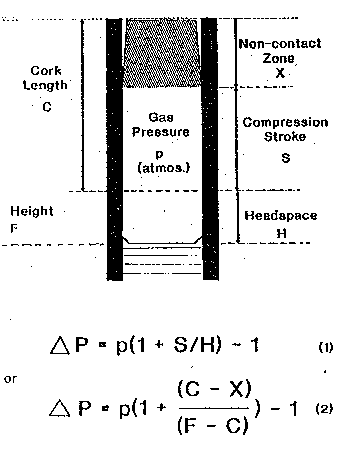
 |
The
figure above shows the way that headspace pressure can be produced at corking; with vacuum corkers, the compression stroke begins when the vacuum line
is blocked by the cork at the start of insertion.
Although the use of CO, flushing and/or vacuum corkers is designed to
circumvent this problem, inadequate vacuum or CO, flush, malfunction, long
compression stroke and small headspace volume will cause or contribute to
excessive headspace pressure.
|
 |
Increases in the temperature of the wine will increase the vapour
pressure of dissolved gases and will also reduce the volume
of the headspace as the wine expands. Estimating
the combined effects is difficult, and it is much easier to insert a hollow
needle attached to a pressure gauge through the cork and record the pressure as
the wine is warmed. A correction must be made for the volume of the hollow
needle and the Bourdon tube of the gauge.
|
 |
Although the partial pressures of nitrogen and CO, in the bottle may be
individually less than atmospheric pressure, their combined pressure may be
significantly greater.
|
 |
If there is hetero-fermentative activity in the
bottle, it is desirable
that leakage occurs before high pressures are produced.
|
Comments on question 6
 |
When a particular bottling has a higher rate of leakage than to other
bottlings, it is tempting Attribute the problem to an intrinsic lack of sealing
ability of the corks. The
likelihood of this being the case can be assessed by checking the bottles for
residual pressure, SO2 loss, gas content, headspace volume, weight and dry
weight of the corks and current seal pressure, and calculating the initial
headspace pressure.
|
Comments on question 8
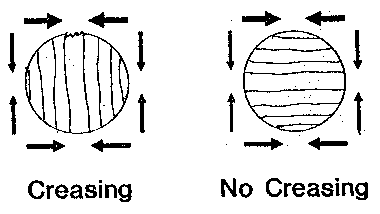
 |
Irregular compression will not crease every
cork, only those which enter
the compression chamber with their growth rings at right angles to the major
tangential stress, (Figure above).
|
Comments on question 9
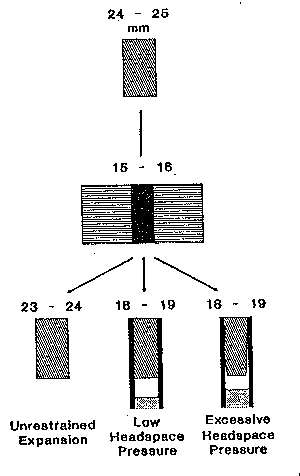
 |
Excessive pressure after corking prevents the cork from making complete
contact with the neck of the bottle. It
is not true to say that the lack of contact is because the cork requires time to
recover its original diameter. The
oft cited data on recovery times refer to corks which have been compressed for
24 hours. Depending on the moisture content of the cork, momentary compression
to 15 - 16 mm has little or no lasting effect on its diameter, and in the
absence of excessive headspace pressure, the cork makes effective contact with
the glass surface, (Figure above).
|
Comments on question 10
 |
Wine staining on the cylindrical surface of the cork shows the extent of
wine contact at some stage with that part of the cork.
It does not necessarily mean that the bottle has leaked or that it is
likely to leak. Figure 4 shows some
common staining patterns.
|
Comments on question 12
 |
Corks commonly increase in weight by a gram, or more after insertion as
they absorb liquid vapour. This is
enough to lower the wine level by several millimetres; in conjunction with wine
staining of the cylindrical surface of the cork, it can create the impression
that the bottle has leaked.
|
Comments on question
13
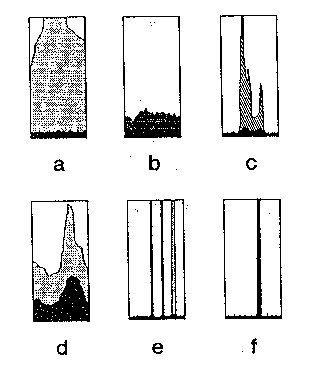
 |
The sealing ability of many corks is only as good as their least
effective region, (Figure above).
|
Comments on question
15
 |
After a certain amount of
leakage, the headspace volume is increased and
the maximum pressure in the bottle is reduced to less than the seal pressure of
the cork. There will be no further
leakage unless there are unusually high temperatures during storage or transport,
or until the terminal stages of the cork's useful life
|
Comments on question
16
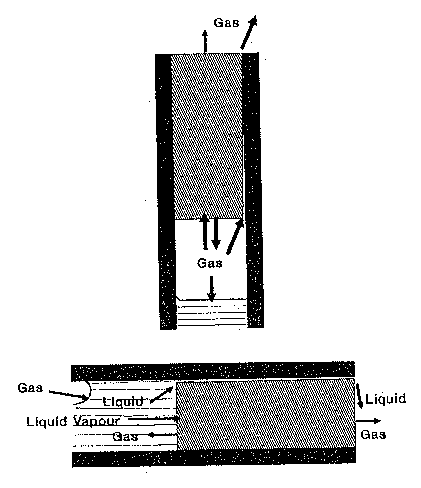
 |
The decline in pressure produced at corking is due mainly to the
dissolution of headspace gases in the wine, and the venting of gas or liquid
between the cork and the glass. Reaction
of oxygen with constituents of the wine, and the permeation of CO, and liquid
vapour into the cork can also contribute to the reduction in pressure, (Figure above).
|
Summary
 |
Wine bottles leak when their internal pressure exceeds the sealing
pressure of the closure, i.e. because of excessive internal pressure, inadequate
sealing pressure or a combination of both.
|
 |
Leakage of wine usually stops after a certain amount of wine has been
expelled from the bottle, because of the consequent decrease in internal pressure. Although leakage may recommence if the temperature of the wine increases, the extent of any subsequent leakage is diminished by the cushioning
effect of the now enlarged headspace volume.
|
 |
Pressure in wine bottles can be generated by compression of the gas in
the headspace when the cork is driven into the neck of the bottle, and also when
the wine expands with increases in temperature. Although excessive pressure produced at corking decreases
gradually as some of the compressed gas dissolves in the wine, it has a
deleterious effect on the seal pressure of the cork, particularly if the wine
remains in contact with the cork during the period immediately after bottling,
i.e., before the pressure has decreased. In addition, any residual corking pressure also increases the amount of pressure
generated when the temperature of the bottled wine rises during storage and transport.
|
 |
Excessive pressure produced at corking is directly and indirectly a major
cause of leakage, although wine bottlers will always claim that other batches of
corks inserted under similar conditions have not leaked.
These claims may be genuine in some cases, but they still do not
exonerate deficiencies in the corking operation.
Failure to observe best practice in the corking and storage of wine
bottles increases the incidence and magnitude of any subsequent leakage.
|
 |
After insertion, the sealing pressure of all corks declines over a period
of time. The sealing life of a cork
will depend on the extent of its exposure to prolonged pressure and liquid, and also on its intrinsic ability to endure strain
and impede the entry of liquid vapour. Nevertheless,
even when the sealing pressure of a cork is very low, for leakage to occur, the
internal pressure in the bottle must be greater than atmospheric pressure.
|
For discussion or question please do not hesitate to
contact us.
Best regards
Christian Hülsemann
Für Diskussion und Fragen stehen wir Ihnen selbstverständlich zur Verfügung. Nehmen Sie gerne Kontakt zu uns auf
und wir freuen uns auf ein persönliches Gespräch. Mit den besten Grüßen Christian Hülsemann
|




